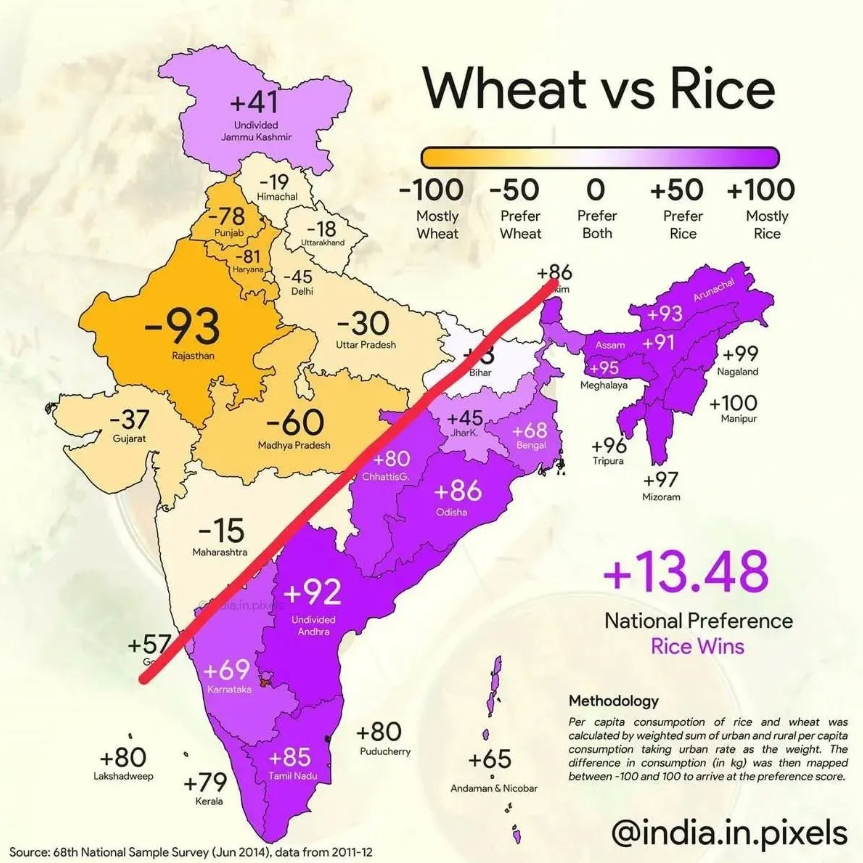Wheat vs Rice Production Map of India


Alex Cartwright
Senior Cartographer & GIS Specialist
Alex Cartwright is a renowned cartographer and geographic information systems specialist with over 15 years of experience in spatial analysis and data...
Geographic Analysis
What This Map Shows
The "Wheat vs Rice Production Map of India" provides a comparative visual representation of the areas where wheat and rice are primarily cultivated across the country. By showcasing the geographic distribution of these two staple crops, the map highlights the regions where each crop thrives, offering insights into agricultural practices and regional preferences in cropping. With India being one of the largest producers of both wheat and rice globally, understanding this distribution is crucial for grasping the agricultural landscape of the nation.
Deep Dive into Wheat and Rice Cultivation in India
Wheat and rice are not just staples of the Indian diet; they are also pivotal to the country's economy and culture. Wheat is predominantly grown in the northern states, especially in Punjab, Haryana, and Uttar Pradesh. These states benefit from the fertile alluvial soil and favorable climatic conditions, which contribute to high yields. Interestingly, Punjab alone accounts for about 45% of India’s total wheat production, showcasing its agricultural prowess.
On the other hand, rice is primarily cultivated in the eastern and southern regions, with states like West Bengal, Uttar Pradesh, and Andhra Pradesh leading in production. The climate in these regions, characterized by high rainfall and humidity, is ideally suited for rice cultivation. For instance, West Bengal contributes to nearly 15% of the total rice produced in India, thanks to its abundant water resources and favorable agricultural practices.
The contrast in cultivation practices is significant as well. Wheat is mainly a rabi (winter) crop, planted in October and harvested in March-April, whereas rice is predominantly a kharif (monsoon) crop, sown with the onset of the monsoon in June and harvested in September-October. Such differences in cropping seasons reflect not only the climatic variations across regions but also the cultural practices surrounding agriculture in India.
Moreover, the map reveals the interdependence of these crops. Farmers often rotate between wheat and rice based on water availability, soil health, and market demand. This strategic crop rotation helps in maintaining soil fertility and ensuring sustainable agricultural practices. Ever wondered why some farmers choose to grow one over the other? It often boils down to economic factors, including market prices, government subsidies, and local food security needs.
Regional Analysis
Analyzing the map further, we see distinct patterns in wheat and rice cultivation across various Indian regions. In the northern belt, the predominance of wheat is evident, with states like Punjab and Haryana showcasing significant wheat fields. These states have benefitted from the Green Revolution, which introduced high-yield varieties and improved irrigation techniques.
Conversely, the eastern states such as West Bengal, Odisha, and Assam are rice powerhouses. The map indicates that these regions not only grow rice for local consumption but also for export. The fertile delta regions, particularly the Sundarbans in West Bengal, create optimal conditions for rice farming. Interestingly, while Uttar Pradesh produces large quantities of both wheat and rice, its agricultural diversity reflects the adaptability of its farmers to different cropping systems.
In southern India, states like Tamil Nadu and Karnataka also contribute to rice production, but their cultivation methods often incorporate advanced irrigation techniques, given the erratic monsoon patterns. This highlights the innovative approaches adopted by farmers to ensure productivity despite climatic challenges.
Significance and Impact
The significance of understanding the distribution of wheat and rice production in India cannot be overstated. As the country faces challenges like climate change and population growth, the demand for these staples is only expected to rise. With projections indicating an increase in food demand by 70% by 2050, optimizing wheat and rice production becomes crucial for food security.
Moreover, fluctuations in crop yields directly impact the economy, livelihoods, and nutrition of millions. The Indian government has implemented various schemes to support farmers, from minimum support prices to crop insurance schemes, which play essential roles in stabilizing these sectors.
In conclusion, the "Wheat vs Rice Production Map of India" is more than just a visual representation; it encapsulates the agricultural diversity, economic significance, and cultural importance of these staple crops. By understanding this map, one gains a deeper appreciation for the complexities of Indian agriculture and the ongoing efforts to ensure food security in a rapidly changing world.
Visualization Details
- Published
- August 11, 2025
- Views
- 202
Comments
Loading comments...